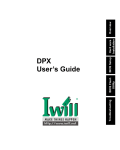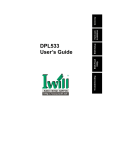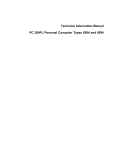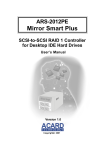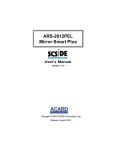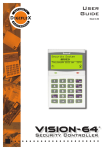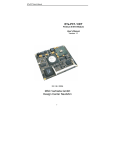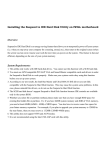Download DPX2-S320 User`s Guide
Transcript
Overview DPX2-S320 User’s Guide Overview i IWILL Corp. makes no warranty of any kind with regard to this material, including, but not limited to, the implied warranties of merchantability and fitness for a particular purpose. IWILL Corp. shall not be liable for errors contained herein or for incidental or consequential damages in connection with the furnishing, performance, or use of this material. We assumes no responsibility for the use or reliability of its software on equipment that is not furnished by IWILL Corp. This document contains proprietary information that is protected by copyright. All rights are reserved. No part of this publication may be reproduced, transcribed, stored in a retrieval system, translated into any language or computer language, or transmitted in any form whatsoever without the prior written consent of IWILL Corp. Copyright? 2003 by IWILL Corp. All rights reserved. IWILL is the trademark of IWILL Corp. Other products and companies referred to herein the trademarks or registered trademarks of their respective companies or mark holders. Printed in Taiwan Revision Version: 1.00 Release Date: May 2002 FCC Guidelines This equipment has been tested and found to comply with the limits for a Class B digital device, pursuant to Part 15 of the FCC rules. These limits are designed to provide reasonable protection against harmful interference in a residential installation. This equipment generates, uses and can radiate radio frequency energy and, if not installed and used in accordance with the instructions may cause harmful interference to radio communications. However, there is no guarantee that interference will not occur in a particular installation. If this equipm ent does cause harmful interference to radio or television reception, which can be determined by turning the equipment off and on, the user is encouraged to try to correct the interference by one or more of the following measures: • Reorient or relocate the receiving antenna. • Increase the separation between the equipment and the receiver. • Connect the equipment into an outlet on a circuit different from that to which the receiver is connected. • Consult the dealer or an experienced radio TV technician for help. • Use only shielded cables to connect I/O devices to this equipment. This device complies with Part 15 of the FCC Rules. Operation is subject to the following two conditions: (1) This device may not cause harmful interference. (2) This device must accept any interference received, including interference that may cause undesired operation. Overview ii Overview The information in this document is subject to change without notice Thank you for choosing the IWILL DPX2-S320 high performance Server motherboard. The DPX2-S320 is a dual Socket-604 motherboard (M/B) based on the ATX form factor. As the latest Intel MCH E7501 with South Bridge ICH3; PCI-X Bridge P64H2 is built in the M/B, DPX2-S320 fully ® supports Intel Prestonia socket 604 processor at 400/533 MHz FSB (Front Side Bus) frequency. In memory support, DPX2-S320 provides six DIMMs for the system memory. Users just simply choose PC1600/PC2100 (DDR200/DDR266), registered with ECC DIMMs as the system memory and the total maximum memory size can be up to 12GB. Flexibility and expandability are always concerned by IWILL, DPX2-S320 contains one PCI-X 64bit/133 or 66 MHz slot, two PCI-X 64bit/100MHz slots; three PCI-32bit/33Mhz slots、 for numerous add-on cards and provides Peer PCI transaction support to increase system performance. Other features such as onboard Adaptec AIC-7902 dual channel Ultra 320 ® SCSI interface、 dual Intel (82540EM) Gigabit Ethernet controllers and onboard Ati RageXL video controller with 8MB memory will provide high system capabilities that meet a wide range of demanding Sever applications. Unpacking Remove all items from the box and make sure you have these following items: ? ? One IWILL DPX2-S320 motherboard ? ? One Floppy ribbon cable ? ? One ATA /100 IDE ribbon cable ? ? One 68-pin (female) SCSI cable ? ? One bag of spare jumpers ? ? One CD containing drivers and utilities ? ? One DPX2-S320 User’s Guide If you discover damaged or missing items, please contact your retailer. Overview iii Overview Overview ® CPU I. VRM Support I. Chipset I. Use the latest Intel MCH E7501 with South Bridge ICH3 chipset in the DPX2-S320 M/B. System Memory Support I. DPX2-S320 provides six memory DIMMs and supported total system memory size can up to 16GB. A user just chooses specific PC1600/PC2000 (DDR 200/266), registered with ECC DIMMs and DIMMs support up to 12GB technology that will allow up to 128/256/512/1024 Mbyte per two row (Double sided DIMM) as the system memory. II. Support dual Intel Xeon Socket 604 CPUs at 400/533 MHz Host Bus Interface Integrated VRM complies to spec 9.1 ® VGA I. ATI RageXL video controller with 8MB memory not upgradeable. SCSI I. Adaptec AIC-7902W Ultra 320 SCSI supports dual channels for bandwidth up to 320MB/s. Ethernet I. Dual Intel (82540EM) Gigabit/10/100 Ethernet controllers on board. A user can achieve advanced manageability of the Alert on LAN II Specification by using ® this Intel 82540EM chip. II. Expansion Slots I. II. III. IV. Overview ® One PCI-X 64bit/66 or 133Mhz slot. (Depends on the number of add-on card insert in PCI-X 100MHz slot. Two PCI-X 64bit/100MHz slots; Three PCI-32bit/33MHz slots; The advantage from 64-bit/66MHz PCI iv Overview Features Highlight Super Multi-I/O I. II. III. IV. NS super I/O (PC87360) One serial ports with UART 16550 Dual onboard USB v1.1 connectors; One extendable USB header PS/2 mouse and keyboard connectors with Wake-up function Intelligent Platform Manage Interface I. II. III. Hardware Monitor by ADM1026 AMC connector for BMC module Hardware monitor of CPU Thermal Protect, CPU/System Fan monitor, Voltage Report, Chassis Intrusion Enhanced ACPI I. Fully implements the ACPI standard for FreeBSD /RedHat /Windows 2000 compatibility, and supports soft off. I. II. III. Redundant power supply controller ready Alert on LAN ready Remote system controller ready Desktop Management Interface (DMI) I. Supports DMI through BIOS, which allows hardware to communicate within a standard protocol creating a higher level of compatibility. PC99 Compliant I. The DPX2-S320 is fully compliant with the Microsoft PC99 specification at both the hardware and BIOS levels. Dimension I. SSI form factor-12’x13” System Management Overview v Overview technology is the theoretical bandwidth can be up to 528MB/s. This manual explains how to build your system with DPX2-S320 in detail. Please follow the procedures of this User Manual carefully and pay special attention to these icons. IMPORTANT WARNING NOTE TIP Overview This icon informs you for particularly important details regarding the setup or maintenance of your system. While we point out the most vital paragraphs in a chapter, you should always read every word carefully. Failing to do so can cause exasperation. This icon alerted you for potential dangers during setting up your system with DPX2-S320. These warnings should not be regarded as the whole of your safety regimen. Never forget that computer are electronic devices and are capable of delivering a shock. Prevent damage to yourself and to your board: always ensure that your system is turned off and unplugged the power cords whenever you are working with it, and that you are equipped This icon alerted you for notice during setting up your system. It provides you can useful alert during setting up a new system. This icon will show you how to configure your system with DPX2-S320 in an easy and simple ways. This icon always provides some useful description to help you configure your system. vi Overview About This User Guide If a problem arises with yours system during installation or OS operating, you should ask your dealer for help first as your system has most likely be configured by them. They always have the best idea and quick response for your symptoms. If your dealer is near to your locations, you should bring your system to them to have it quickly serviced instead of attempting to solve the problem by yourself. Besides these, IWILL also provides some helpful resources to help you. 1. Select IWILL’s website at www.iwill.net and navigate to this product page which contain links to product updates such as Jumper settings or BIOS updates. 2. FAQ sections on IWILL Website are often helpful since other user’s questions are often your own. 3. Email us at: [email protected] and we will try to answer your questions within 24 hours. Before you email your symptom to [email protected] please fill in the symptom report in order to let our engineers solve your problem quickly. Overview vii Overview Getting Help Overview viii Overview DPX2-S320 Motherboard (Picture) Overview ix Overview DPX2-S320 Motherboard (Layout) Overview This page left intentionally blank for notes Overview x Chapter 1 Hardware Installation In this chapter, the installation of the DPX2-S320 with the processor and other hardware connected to your system will be explained in detail. Installation Procedures Installation procedures will be broken up into six major parts. Step 1:Jumper setting Step 2: Install memory (DDRAM modules) Step 3: Install Prestonia CPU Step 4: Attach cables to connectors Step 5: Install expansion cards Step 6: Power connection Warning This motherboard contains sensitive electronic components that can be easily damaged by static electricity. Follow the instructions carefully to ensure correct installation and to avoid static damage. BIOS 2 1 Step 1. Jumper Setting 1. Clear COMS Header The onboard button cell battery powers the CMOS RAM. It contains all the BIOS setup information. Normally, it is necessary to keep the jumper connected to pin2 and pin3 (Default) to retain the RTC data as shown below. Note Should you want to clear the RTC data: (1) Soft off your computer (2) Short pin1 and pin2 with jumper for few seconds (3) Connect pin2 and pin3 with jumper (4) Turn on your computer by pressing the power-on button from front-panel. BIOS 2 2 (5) Hold down <Delete> during bootup and select <Load Optimal Defaults> or <Load Failsafe Defaults> option in the selection “Exit”. Then re-enter BIOS setup to re-enter user preferences. BIOS 2 3 Step 2 Install Memory DPX2-S320 uses Dual Inline Memory Modules (DIMM). Six DIMM sockets are available for 2.5 Volts (power level), PC1600 (DDR200) and PC2100 (DDR266), Double Data Rate Memory (DDR) with 128MB, 256MB, 512MB, and 1GB combinations. And the total memory size is between 128MB and 12GB. IMPORTANT II. III. IV. As DPX2-S320 has strict memory type and timing requirements. Hence, before you attend to buy the DDR DIMM (Double Data Rate) and use in the DPX2-S320, please consult your local reseller for memory suggestion first. DPX2-S320 only supports PC1600 (DDR200) or PC2100 (DDR266) compliant at 100/133 MHz DDR modules. Since the DPX2-S320 memory bus is synchronized to front side bus (FSB) speed, it is not allows a user to use PC200 DIMM with 100 MHz FSB CPU in the DPX2-S320. Otherwise system may not able to bootup. When a user uses PC1600 (DDR200) DIMM with 100 FSB CPU, it will result in 100MHz memory speed operation. Memory Installation Procedures 1. Locate the DIMM modules on the DPX2-S320. 2. Make sure the DIMM module’s pins face down and match the socket’s size as depicted below. BIOS 2 4 80 Pins 104 Pins 3. Insert the module down to the DIMM socket in with both hands and press down firmly until the DIMM module is securely in place. (The tabs of the socket will close-up to hold the DIMM in place when the DIMM touches BIOS 2 5 the socket’s bottom.) DDR-A1 DDR-B1 DDR-A2 DDR-B2 DDR-A3 DDR-B3 4.Repeat step1 to step 3 to add additional DIMM modules. IMPORTANT You have to insert two memory DIMMs in #DDR-A1 and #DDR-B1 or #DDR-A2 and #DDR-B2 or #DDR-A3 and #DDR-B3 DIMMs sockets (slots or connectors) while you install the system at the first time that you want to use it ; such as the system will be able to boot up, otherwise, it can not work yet. BIOS 2 6 Step 3 Install CPU ® DPX2-S320 provides Intel Xeon Socket 604 processor at 400/533 MHz FSB CPU Installation Procedures 1. Lift up the socket lever and carefully place the Socket 604 CPU with the correct orientation as the figures are shown below 2. Mount the CPU heatsink with exproxy and secure it with the lock as the figures are shown below. 3. Plug the 3-wire fan power core into the connector named CPI1 FAN 4. Repeat to install the other CPU BIOS 2 7 Bl ac Wi k - re col or BIOS Re d- Wi colre or Ye llo Wi w- re col or 2 8 Step 4. Attach Cable to Connectors This step explains where each connector is inserted on the DPX2-S320. There will be a DPX2-S320 layout picture following each explanation indicating where the connector is inserted. The motherboard connectors are: BIOS 2 9 Item 1 2 3 4 5 6 7 8 9 10 11 12 13 14 15 16 17 18 19 20 21 22 BIOS Connectors ATX Power Supply Floppy Disk Drive Connector Primary IDE Connectors Reset Switch SCSI Hard disk Card Activity LED Hard Disk Activity LED Speaker Connector ATX Power Switch / Soft Power Switch System Power LED Front, Back, CPU and Aux Fan Connectors Wake-On-LAN PS/2 Mouse Connector PS/2 Keyboard Connector Universal Serial BUS Ports 0 & 1、1 & 2 Parallel Printer Connector Onboard LAN Port Serial Port COM1/2 Connectors Chassis Intrusion Sensor Connector System Thermal Sensor Connector IPMB Connector Adaptec 7899W SCSI Channels System health Header Page 1-12 1-13 1-14 1-15 1-15 1-15 1-16 1-16 1-16 1-16 1-17 1-18 1-18 1-18 1-19 1-19 1-19 1-20 1-20 1-21 1-22 1-23 2 10 1. ATX Power Supply (24-pin ATX power connectors) The connectors connect to ATX power supply. Find the proper orientation and push down firmly to make sure that the pins are aligned. For Wake on LAN support, 5-volt Stand-by lead (+5VSB) from ATX power supply must supply at least 720mA. IMPORTANT ??IWILL always recommand our customers to use ATX Power that has more than 300W power capacity and is capatible with Intel ATX 2.03 specification. 2. Floppy Disk Drive Connector (34-pin FLOPPY) This connector supports the provided floppy disk drive ribbon cable. After connecting the single end to the board, connect the plug on the other end to the floppy drive. BIOS 2 11 3. Primary IDE connectors (One 40-pin IDE) Connect the single end to the board, connect the two plugs at the other end to your hard disk(s). If you install two hard disks in the same cable, you must configure the second drive to Slave mode by setting its jumper accordingly. Please refer to the documentation of your hard disk for the jumper settings. BIOS now supports IDE HDD or IDE CD-ROM bootup (Pin 20 is removed to prevent inserting in the wrong orientation when using ribbon cables with pin 20 plugged), and it support Ultra DMA 33、DMA 66、DMA 100 device. BIOS 2 12 IMPORTANT Ribbon cables should always be connected with the red stripe on the Pin 1 side of the connector. IDE ribbon cable must be less than 46cm (18inches), with the second drive connector no more than 15cm (6 inches) from the first connector. BIOS 2 13 Figure 4-1 Item 4 through 9 are depicted in Figure 4-1 as above. 4. Reset Switch (2-pin RST) This 2-pin connector connects to the case-mounted reset switch for rebooting your computer without turning off and on your power switch. This is a preferred method of rebooting to prolong the life of the system’s power supply. 5. SCSI Hard disk Card Activity LED (4-pin SCSI_HD) The 4-pin connector can be connected to the 4-pin activity LED connector of SCSI card, Read and Write activities by devices connected to the SCSI card will cause the front panel LED to light up. 6. Hard Disk Activity LED (2-pin HDD_LED) This connector supplies power to the cabinet’s hard disk or IDE activity LED. Read and write activity by devices connected to the Primary or Secondary IDE connectors will cause the LED to light up. 7. Speaker Connector (4-pin SPEAKER) BIOS 2 14 There is one jumper cap over pin1 and pin2 (default setting) for internal buzzer. If you want to use external case-mounted speaker instead of internal buzzer, remove jumper cap and connect speaker wire to the 4-pin connector. 8. ATX Power Switch / Soft Power Switch (2-pin PWR_SW) A momentary switch connected to these connector controls the system power. Pressing the button once will switch the system between ON and SLEEP. The system power LED shows the status of the system’s power. 9. System Power LED (3-pin PWR_LED) This 3-pin connector connects the system power LED, which lights up when the system is powered on and blinks when it is in sleep mode. 10. Front, Back, CPU and Aux Fan Connectors (3-pin FAN) There are eight 3-pin fan connectors in the DPX2-S320 M/B. Two fans are used for CPU1 and CPU2; six are for auxiliary power. These connectors support cooling fans of 500mA (6W) or less. Depending on the fan manufacturer, the wiring and plug may be different. Connect the fan’s plug to the board taking into consideration the polarity of this connector. BIOS 2 15 WARNING The CPU and/or motherboard will overheat if there is not enough airflow across the CPU and onboard heatsink. Damage may occur to the motherboard and/or the CPU fan if these pins are incorrectly used. These are not jumpers; do not place jumper caps over these pins. NOTE I. II. The “Rotation” signal has to be used with fan specially designed with rotation signal. Only the fan marked CPU Fan1, CPU2 Fan2, Front fan and back fan can be monitored by BIOS. 11. Wake-On-LAN This connector connects to internal LAN cards with a Wake-On-LAN output. The connector powers up the system when a wakeup packet or signal is received through the LAN card. BIOS 2 16 IMPORTANT This feature requires that your system have an ATX power supply with at least 720mA +5VSB standby power. Figure 4-2 BIOS 2 17 Item 12 through 17 are depicted in Figure 4-2 as above. 12. PS/2 Mouse Connector (6-pin Female) The upper port The system will direct IRQ12 to the PS/2 mouse if one is detected. If not detected, expansion cards can use IRQ12. 13. PS/2 Keyboard Connector (6-pin Female) The lower port This connection is for a standard keyboard using a PS/2 plug (mini DIN). This connector will not allow standard AT size (large DIN) keyboard plugs. You may use a DIN to mini DIN adapter on standard AT keyboards. 14. Universal Serial BUS Ports I & 2 (Two 4-pin Female) Two external USB ports and two internal USB headers are available for connecting USB devices. But a user cans only two of them with proper cabling for connecting USB. 15. Parallel Printer Connector (25-pin Female) You can enable the parallel port and choose the IRQ through the BIOS Setup. 16. Onboard LAN Ports DPX2-S320 integrates dual Intel? 82540EM Gigabit Ethernet controllers. BIOS 2 18 It consists of both the Media Access controller and 10/100 Mbps Physical Layer (PHY) interface. The RJ45 connector provides both 10Base-T and 100Base-TX connectivity. Please refer to the “Onboard SCSI/LAN User Guide” for further information. 17. Serial Port COM1/2 Connectors (9-pin Male and 10-pin Header) The serial port COM1 and COM2 can be used for pointing devices or other serial devices. See the BIOS Setup. 20. System Thermal Sensor Connector (2-pin SYS_THERM) This two-pin connector provides a user to use the thermal sensor to detect the temperature of the components on motherboard. 21. Adaptec 7902W SCSI Channels DPX2-S320 use Adaptec 7902W SCSI Chip and provides two types of common internal SCSI connectors and two connectors for SCSI devices. Please refer to the “Onboard SCSI/LAN User Guide” for further information. BIOS 2 19 22. System health Header (Two 2-pin headers and Two 3-pin headers) DPX2-S320 provides two 2-pin LED, one 3-pin LED and one 2-pin Alarm reset headers for front-panel system health status. When the CPU 1/CPU2 temperature and /CPU1/CPU2/FRONT_FAN/BACK_FAN speed is over alert threshold or the network link loss, system occur audio alarm signal to alert the network administrator. Please also check the System Health Monitoring Hardware in the BIOS setup for Alarm threshold setup. BIOS 2 20 NOTE This header is only for IWILL 1U solution. Users may not found these LED wires in the front panel of their chassis. BIOS 2 21 Header ALARM_RST Description Reset the Alarm status when abnormal situation is solved. SYS_FAIL_LED Detect if the system fail or normal. Green LAN 1 LED / LAN 2 LED Detect if the Network connections of onboard LAN1/LAN2 are linking. Flash BIOS Normal Abnormal Red 2 22 Step 5. Install Expansion Cards WARNING Power off your power supply completely when adding removing any expansion cards or other system components. Failure to do so may cause severe damage to both your motherboard and expansion cards. 1. Expansion Card Installation Procedure 1.1 Read the documentation for your expansion card and makes any necessary hardware or software setting changes, such as jumpers. 1.2 Remove the bracket plate on the slot you intend to use. Keep the bracket for possible future use. 1.3 Carefully align the card’s connectors and press firmly. 1.4 Secure the card on the slot with the screw you removed above. 1.5 Jump to step 6 to finish installation, and then set the IRQ and DMA as follows. 2. Assigning IRQs for PCI Expansion Cards An IRQ number is automatically assigned to PCI expansion cards. In the PCI bus design, the BIOS automatically assigns an IRQ to a PCI slot that contains a card requiring an IRQ. To install a PCI card, you need to set the INT (interrupt) assignment. Since all the PCI slots on this motherboard use an INTA #, set the jumpers on your PCI cards to INTA. BIOS 2 23 Step 6. Powering on Your Computer 1. Be sure that all switches are off (in some systems, marked with “O”). 2. After finishing all jumper settings and connections, close the system case cover. 3. Connect the power supply cord into the power supply located on the back of your system case. 4. Connect the power cord into a power outlet that is equipped with a surge protector. 5. You may then turn on your devices in the following order: I. Your monitor II. External SCSI devices (starting with the last device on the chain) III. Your system power. For ATX power supplies, you need to switch on the power supply as well as press the ATX power switch on the front of the case. 6. The power LED on the front panel of the system case will light up. For ATX power supplies, the system LED will light up when the ATX power switch is pressed. The monitor LED may light up after the system’s LED if it complies with “green” standards or if it has a power standby feature. The system will then run power-on tests. While the tests are running, additional messages will appear on the screen. If you do not see anything within 30 seconds from the time you turn on the power, the system may have failed a power-on test. Recheck your jumper settings and connections or call your retailer for assistance. 7. During power-on, hold down <Delete> to enter BIOS setup. Follow the instructions in the next chapter, BIOS Setup. BIOS 2 24 Note Powering Off your computer You have to first exit or shut down your operating system before switching off the power switch. For ATX power supplies, you can press the ATX power switch after exiting or shutting down your operating system. BIOS 2 25 Chapter 2 BIOS Setup This chapter discusses the PhoenixBIOS Setup program built into the ROM BIOS. The Setup program allows users modifying the basic system configurations according to their requirements. This special information is then stored in battery-backed RAM so that it retains the Setup information when the power is turned off. The PhoenixBIOS installed in your computer system’s ROM (Read Only Memory) is a custom version of an industry standard BIOS. The BIOS provides critical low-level support for standard devices such as disk drives and serial and parallel ports. The PhoenixBIOS has been customized by adding important, but non-standard, features such as password protection as well as special support for detailed fine-tuning of the chipset controlling the entire system. The rest of this chapter is intended to guide you through the process of configuring your system using Setup. Starting BIOS Setup The PhoenixBIOS is immediately activated when you power on the computer every time. The BIOS reads the system information contained in the CMOS and begins the process of checking out the system and configuring it. After finishing configuring the whole system, then BIOS will continue to seek an operating system on one of the disks, launch then turn control over to the operating system. While the BIOS is in control, the Setup program can be activated in one of two ways: 1. BIOS By pressing the <F2> key when the following message appears briefly at the bottom of the screen during the POST (Power On Self-Test). Press F2 to enter SETUP. 2 26 2. By pressing <Del>immediately after switching the system on. If the message disappears before you respond and you still wish to enter Setup Program, restart the system from state “On” to state “Off” by pressing the "RESET" button on the system case. You may also restart the system by simultaneously pressing <Ctrl>, <Alt>, and <Delete> keys. If you do not press the keys at the correct time and the system does not boot as well, an error message will be displayed and you will again be asked to... PRESS F1 TO CONTINUE, F2 TO ENTER SETUP Using Setup In general, you use the arrow keys to highlight items, press <Enter> to select, press <Esc> to quit. The following table provides more details about how to navigate in the Setup program using the keyboard. Key Up Arrow(?) Key Down Arrow(?) Key Left Arrow(?) Key Right Arrow(?) Key Esc key Enter Key PgUp Key PgDn Key + Key - Key BIOS Function Move to the previous item Move to the next item Move to the previous item Move to the next item In the Sub-menu: Exit the sub-menu. In the BIOS main category: Quit Without saving changes. Select the item. A pop-up selection will display on the screen and allows to set the item value. Increase the numeric value or make change Decrease the numeric value or make change Increase the numeric value or make change Decrease the numeric value or make change 2 27 Key Function General Help on Setup navigation keys. Press <F1> key to pop up a small help window that describes the appropriate keys to use and the possible selections for the highlighted item. To exit the Help Window, press <ESC> key or <F1> key again. F5 Key Load Previous value for this page F6 Key Load Failsafe Defaults for this page F7 Key Load Optimal Defaults this page F10 key Save configuration and exit the BIOS Setup Utility Table 1 Legend Keys Navigating through the menu bar Use the left and right arrow keys to navigate the menu you want to be in. F1 Key To display a sub menu Use the arrow keys to move the cursor to the sub menu you want. Then press <Enter>. A “>” pointer marks all sub menus. BIOS 2 28 In Case of Problems If after making and saving system changes with Setup, you discover that your computer no longer is able to boot, the PhoenixBIOS supports an override to the CMOS setting, which resets your system to its defaults. The other way is clear the present CMOS information. (Refer to the jumper setting.) The best advice is to only alter settings, which you thoroughly understand. In the end, we strongly recommend that you avoid making any changes to the chipset defaults. These defaults have been carefully chosen by both PhoenixBIOS to provide the maximum performance and reliability of the system. Even a slight change to the chipset setup may also cause potential and unpredictable failure to the system. BIOS 2 29 Section 1 Main Menu To start the PhoenixBIOS Setup utility: Step 1: Turn on or reboot your system.PhoenixBIOS displays this message: Step 2: Press <F2> to enter SETUP Step 3: Pressing <F2> displays the Main Menu, which looks like this: PhoenixBIOS Setup Utility Main Advanced Power Boot System Time: System Date: [16:19:20] [03/02/1994] Legacy Diskette A Legacy Diskette B [1.44/1.25 MB 3½ ”] [Not Installed] > Primary Master > Primary Slave > Secondary Master > Secondary Slave System Memory: Extended Memory: F1 Help ESC Exit ? ? Select Item ? Select Menu PIR Exit Item Specific Help <Tab>, <Shift-Tab>, or <Enter> selects field 6449 MB None CD-ROM None 640 KB 523264 KB -/+ Change Values F9 Setup Defaults Enter Select?Sub-Menu F10 Save and Exit Step 34: for a description of the fields on this menu. BIOS 2 30 The Menu Bar The Menu Bar at the top of the window lists these selections: Key <F1> or <Alt-H> <Esc> ? arrow keys ? or ? arrow keys <Tab> or <Shift-Tab> <Home> or <End> <PgUp> or <PgDn> <F5> or <-> <F6> or <+> or <Space> <F9> <F10> <Enter> <Alt-R> Function General Help window (See below). Exit this menu. Select a different menu. Move cursor up and down. Cycle cursor up and down. Move cursor to top or bottom of window. Move cursor to next or previous page. Select the Previous Value for the field. Select the Next Value for the field. Load the Default Configuration values for this menu. Save and exit. Execute Command or Select P Submenu. Refresh screen. Use the left and right ? arrow keys to make a selection. See the section below, "Exiting Setup," for a description on exiting the Main Menu. The Legend Bar Use the keys listed in the legend bar on the bottom to make your selections or exit the current menu. The chart on the following page describes the legend keys and their alternates: Key <F1> or <Alt-H> <Esc> ? arrow keys ? or ? arrow keys <Tab> or <Shift-Tab> <Home> or <End> <PgUp> or <PgDn> <F5> or <-> BIOS Function General Help window (See below). Exit this menu. Select a different menu. Move cursor up and down. Cycle cursor up and down. Move cursor to top or bottom of window. Move cursor to next or previous page. Select the Previous Value for the field. 2 31 <F6> or <+> or <Space> <F9> <F10> <Enter> <Alt-R> Select the Next Value for the field. Load the Default Configuration values for this menu. Save and exit. Execute Command or Select P Submenu. Refresh screen. To select an item, use the arrow keys to move the cursor to the field you want. Then use the plus-and-minus value keys to select a value for that field. The Save Values commands in the Exit Menu save the values currently displayed in all the menus. To display a sub menu, use the arrow keys to move the cursor to the sub menu you want. Then press <Enter>. A pointer (>) marks all sub menus. BIOS 2 32 The Field Help Window The help window on the right side of each menu displays the help text for the currently selected field. It updates as you move the cursor to each field. The General Help Window Pressing <F1> or <Alt-H> on any menu brings up the General Help window that describes the legend keys and their alternates: General Help Setup changes system behavior by modifying the BIOS Configuration parameters. Selecting incorrect values may cause system boot failure; load Setup Default values to recover. <Up/Down> arrows select fields in current menu. <PgUp/PgDn> moves to previous/next page on scrollable menus. <Home/End> moves to top/bottom item of current menu. Within a field, <F5> or <-> selects next lower value and <F6>, <+>, or <Space> selects next higher value. <Left/Right> arrows select menus on menu bar. <Enter> displays more options for items marked with a >, <Enter> also displays an option list on some fields. <F9> loads factory-installed Setup Default values. <F10> restores previous values from CMOS. <ESC> or <Alt-X> exits Setup: in sub-menus, pressing these keys returns to the previous menu. <F1> or <Alt-H> displays General Help (this screen). [Continue] The scroll bar on the right of any window indicates that there is more than one page of information in the window. Use <PgUp> and <PgDn> to display all the pages. Pressing <Home> and <End> displays the first and last page. Pressing <Enter> displays each page and then exits the window. Press <Esc> to exit the current window. BIOS 2 33 Main Menu Selections You can make the following selections on the Main Menu itself. Use the sub menus for other selections. Feature System Time System Date Diskette 1 Diskette 2 System Memory Options HH:MM:SS MM/DD/YYYY 360 kB, 5 ¼ " 1.2 MB, 5 ¼ " 720 kB, 3 ½ " 1.44/1.25 MB, 3 ½ " 2.88 MB, 3 ½ " Not installed Disabled N/A Extended Memory N/A Description Set the system time. Set the system date. Select the type of floppy-disk drive installed in your system. 1.25 MB is a Japanese media format that requires a 3½ " 3-Mode Diskette drive. Displays amount of conventional memory detected during boot up. Displays the amount of extended memory detected during boot up. You can set the boot sequence of the bootable drives by selecting Boot Sequence on the Main Menu or opening the Boot Menu. ?? Master and Slave Sub-Menus The Master and Slave sub-menus accessed from the Main Menu control these types of devices: ?? Hard-disk drives ?? Removable-disk drives such as Zip drives ?? CD-ROM drives PhoenixBIOS 4.0 supports up to two IDE disk adapters, called primary and secondary adapters. Each adapter supports one master drive and one optional slave drive in these possible combinations: ?? ?? ?? ?? ?? 1 Master 1 Master, 1 Slave 2 Masters 2 Masters, 1 Slave 2 Masters, 2 Slaves There is one IDE connector for each adapter on your machine, usually BIOS 2 34 labeled "Primary IDE" and "Secondary IDE." There are usually two connectors on each ribbon cable attached to each IDE connector. When you have connected two drives to these connectors, the one on the end of the cable is the Master. If you need to change your drive settings, selecting one of the Master or Slave drives on the Main Menu displays a sub-menu like this: PhoenixBIOS Setup Utility Main Primary Master [20491MB] Type: [Auto] Multi-Sector Transfers: LBA Mode Control: 32 Bit I/O: Transfer Mode: Ultra DMA Mode: [16 Sectors] F1 Help ESC Exit Item Specific Help [Enabled] [Disabled] [Fast PIO 4] [Mode 2] ? ? Select Item -/+ Change Values F9 Setup Defaults ? Select Menu Enter Select>Sub-Menu F10 Save and Exit Use the legend keys listed on the bottom to make your selections and exit to the Main Menu. Use the following chart to configure the hard disk. BIOS 2 35 Feature Type Options None 1 to 39 User Auto IDE Removable CD-ROM ATAPI Removable Sectors/Track Multi-Sector Transfers 1 to 63 Disabled Standard 2 sectors 4 sectors 8 sectors 16 sectors Enabled Disabled LBA Mode Control 32-Bit I/O Enabled Disabled Transfer Mode Standard Fast PIO 1 Fast PIO 2 Fast PIO 3 Fast PIO 4 Ultra DMA Mode2 Mode 2 Description None = Autotyping is not able to supply the drive type or end user has selected None, disabling any drive that may be installed. User = You supply the hard-disk drive information in the following fields. Auto = Autotyping, the drive itself supplies the correct drive information. IDE Removable = Removable read-and-write media (e.g., IDE Zip drive). CD-ROM = Readable CD-ROM drive. ATAPI Removable = Read-and-writea media (e.g., LS120, USB Floppy, USB Zip). Number of sectors per track. Any selection except Disabled determines the number of sectors transferred per block. Standard is 1 sector per block. Enabling LBA causes Logical Block Addressing to be used in place of Cylinders, Heads, & Sectors. Enables 32-bit communication between CPU and IDE card. Requires PCI or local bus. Selects the method for transferring the data between the hard disk and system memory. The Setup menu only lists those options supported by the drive and platform. * IDE drives do not require setting Landing Zone and Write Precomp. When you enter Setup, the Main Menu usually displays the results of Autotyping– information each drive provides about its own parameters (e.g., cylinders, heads, and sectors)–and how the drives are arranged as Masters or Slaves on your machine. BIOS 2 36 Some older drives, however, do not use Autotyping and require selecting type User and entering a pre-defined fixed-disk type value or specifying the drive parameters separately with the User type selected. You can find the correct parameters for hard-disk drives in the drive manual or written on the casing of the drive itself. Note Before changing the contents of this menu, write them down. Once you have established correct parameters for your drive, write them down and store them in a safe place (e.g., tape them to the disk drive) for use in case these values are lost in CMOS or if autotyping fails. If these hard-disk parameters are not correctly entered in CMOS, you cannot access the data on your drive. WARNING Incorrect settings can cause your system to malfunction. To correct mistakes, return to Setup and restore the Setup Defaults with <F9> and re-enter the correct drive parameters. BIOS 2 37 Section 2 Advanced Menu Selecting "Advanced" from menu bar on the Main Menu displays a menu like this: PhoenixBIOS Setup Utility Main Advanced Power Boot > Advanced Chipset Control > I/O Device Configuration: > Advanced Processor Options > DMI Event Logging Local Bus IDE adapter: Legacy USB Support: [Both] [Enabled] Large Disk Access Mode: Installed O/S: Reset Configuration Data: [DOS] [Windows2000] [No] F1 Help ESC Exit BIOS ? ? Select Item ? Select Menu -/+ Change Values PIR Exit Item Specific Help Select the operating system installed on your system which you will use most commonly. Note: An incorrect setting can cause some operating system to display unexpected behavior. F9 Setup Defaults Enter Select>Sub-Menu F10 Save and Exit 2 38 Use the legend keys to make your selections and exit to the Main Menu. Feature Options Description Advanced Chipset Select options for Advanced Control Chipset features I/O Device Configuration Advanced Processor Select options for processor Options settings DMI Event Logging Event log options Local Bus IDE adapter Enable the integrated local bus IDE adapter Legacy USB Support Large Disk Access Mode DOS Select DOS if you have DOS. Other Select Other if you have another operating system such as UNIX. A large disk is one that has more than 1024 cylinders, more than 16 heads, or more than 63 tracks per sector. Installed O/S Other Select the operating system you use most often. Win95 Win98/NT Reset Configuration Data Yes Yes erases all configuration data No in a section of memory for ESCD (Extended System Configuration Data) which stores the configuration settings for non-PnP plug-in devices. Select Yes when required to restore the manufacturer's defaults. WARNING Incorrect settings can cause your system to malfunction. To correct mistakes, return to Setup and restore the Setup Defaults with <F9>. BIOS 2 39 ?? Advanced Chipset Control Menu Selecting "Advanced Chipset Control Menu" from menu bar on the Main Menu displays a menu like this: PhoenixBIOS Setup Utility Advanced Advanced Chipset Control Graphics Aperture: [ 8MB] Enable memory [Disabled] gap: Memory Remapping [Enable] ECC Config: ECC Error Type SERR signal condition F1 Help ESC Exit Item Specific Help Select the size of the Graphics Aperture for the AGP video device. [ECC] [None] [None] ? ? Select Item -/+ Change Values F9 Setup Defaults ? Select Enter Select > Sub-Menu F10 Save and Exit Menu The chipset is one or more integrated circuits that act as an interface between the CPU and the system's hardware. It manages such things as memory access, buses, and caching. You can use this menu to optimize the performance of your computer. Use the legend keys to make your selections and exit to the Main Menu. Use the following chart in configuring the chipset: BIOS 2 40 Feature Graphics Aperture Enable memory gap Memory Remapping ECC Config Options Enabled Disabled Enabled Disabled ECC Non-ECC ECC Error Type None SERR signal condition None Description If enabled, turn system RAM off to free address space for use with an option card. Either a 128KB conventional memory gap, starting at 512KB, or a 1MB extended memory gap, starting at 15MB will be created in system RAM. If all memory in the system supports ECC (x72) this selection selects from no ECC, checking only, checking and correction, or checking, correction with scrubbing. When an ECC error occurs, it generates an interrupt. Select the type of interrupt to report: NMI Non-Maskable; SMI System Management; SCI System Control. Select ECC error condition that SERR# be asserted. NOTE The contents of this menu depend on the chipset installed on your motherboard, and chipsets vary widely. Consult your dealer or the computer manual before changing the items on this menu. Incorrect settings can cause your system to malfunction. BIOS 2 41 I/O Device Configuration The CPU communicates with external devices such as printers through devices called Inout/Outout (I/O) ports such as serial and parallel ports. These I/O devices require the use of system resources such as I/O addresses and interrupt lines. If these devices are Plug and Play, either the BIOS can allocate the devices during POST, or the operating system can do it. If the I/PO devices are not Plug and Play, they may require manually setting them in Setup. On some systems, the chipset manages the communication devices. Other systems have, instead, a separate I/O chip on the motherboard for configuring and managing these devices. Many systems allow you to control the configuration settings for the I/O ports. Select “I/O Device Configuration” on the Advanced Menu to display this menu and specify how you want to configure these I/O Devices: PhoenixBIOS Setup Utility Advanced I/O Device Configuration Serial port A: Base I/O address: Serial port A: Serial port A: Parallel port: Mode: Base I/O address: Interrupt: DMA channel: Floppy disk controller: F1 BIOS Help [Enabled] [3F8] [Enabled] [2F8] [Enabled] [ECP] [378] [IRQ 7] [DMA 1] [Enabled] ? ? Select Item -/+ Item Specific Help Select the size of the Graphics Aperture for the AGP video device. Change Values F9 Setup Defaults 2 42 ESC Exit ? Select Menu Enter Select > Sub-Menu F10 Save and Exit Use the legend keys to make your selections and exit to the Main Menu. Use the following chart in configuring the chipset: Feature Serial Port A: Serial Port A: Options Disabled Enabled Auto OS Controlled Base I/O Address/IRQ 3F8, IRQ4 2F8, IRQ3 Disabled Enabled Auto Controlled Parallel Port: Mode BIOS Output only Bi-direction al Description Disabled turns off the port Enabled requires you to enter the base Input/Oupout address and the Interrupt number on the next line. Auto makes the BIOS configure the port automatically during POST. OS Controlled lets the PnP Operating System (such as Windows 95) configure the port after POST. If you select Enabled, choose one of these combinations. Disabled turns off the port Enabled requires you to enter the base Input/Oupout address and the Interrupt number on the next line. Auto makes the BIOS configure the port automatically during POST. OS Controlled lets the PnP Operating System (such as Windows 95) configure the port after POST. Output only is standard one-way protocol for a parallel device. Bi-directional uses two-way protocol of an Extended Capabilities Port (ECP) 2 43 Base I/O Address Interrupts 378 278 3BC IRQ5 IRQ7 Diskette Controller Disabled Enabled Base I/O Address Primary Secondary If you select Enabled for the Parallel Port, choose one of these I/O addresses. If you select Enabled for the Parallel Port, choose one of these interrupt options. Enables the on-board legacy diskette controller. Disabled turns off all legacy diskette drives. If you select Enabled for the Diskette Controller, choose Primary for one diskette drive installed or Secondary for two diskette drives installed. NOTE The contents of this menu depend on the chipset installed on your motherboard, and chipsets vary widely. Consult your dealer or the computer manual before changing the items on this menu. Incorrect settings can cause your system to malfunction. BIOS 2 44 Advanced Processor Options Selecting "Advanced Processor " from menu bar on the Main Menu displays a menu like this: PhoenixBIOS Setup Utility Advanced Advanced Processor Options Frequency Ratio Machine Checking Fast String operations Compatible FPU Code Split Lock operations Jackson Technology F1 Help ESC Exit BIOS X 23 Enabled Disabled Enabled Disabled Enabled Disabled Enabled Disabled Enabled Disabled Item Specific Help Select the internal frequency multiplier of the CPU ? ? Select Item -/+ Change Values F9 Setup Defaults ? Select Enter Select > F10 Save and Menu Sub-Menu Exit 2 45 Section 3 The Power Menu Selecting "Power" from the menu bar displays a menu like this: PhoenixBIOS Setup Utility Main Advanced Power Clear CMOS flag [Disabled] Onboard VGA control Onboard SCSI control Onboard LAN 82540EM1 Onboard LAN 82540EM2 [Enabled] [Enabled] [Enabled] F1 Help ESC Exit Boot PIR Exit Item Specific Help Enable/Disable onboard devices. [Enabled] ? ? Select Item -/+ Change Values F9 Setup Defaults ? Select Enter Select > F10 Save and Menu Sub-Menu Exit Use this menu to specify your settings for Power Management. Remember that the options available depend upon the hardware installed in your system. Those shown here are from a typical system. Use the legend keys to make your selections and exit to the Main Menu. Use the following chart in making your selections: BIOS 2 46 Feature Clear CMOS Flag Onboard VGA control Onboard SCSI control Onboard Lan 82540EM1 Onboard Lan 82540EM1 BIOS Options Enabled Disabled Enabled Disabled Enabled Disabled Enabled Disabled Enabled Disabled Description Enable/Disable CMOS setting Enable/Disable onboard controller Enable/Disable onboard controller Enable/Disable onboard 82540EM controller Enable/Disable onboard 82540EM controller VGA SCSI LAN1 LAN2 2 47 Section 4 Boot Menu After you turn on your computer, it will attempt to load the operating system (such as Windows 98) from the device of your choice. If it cannot find the operating system on that device, it will attempt to load it from one or more other devices in the order specified in the Boot Menu. Boot devices (i.e., with access to an operating system) can include: hard drives, floppy drives, CD ROMs, removable devices (e.g., Iomega Zip drives), and network cards. Note Specifying any device as a boot device on the Boot Menu requires the availability of an operating system on that device. Most PCs come with an operating system already installed on hard-drive C:\ Selecting "Boot" from the Menu Bar displays the Boot menu, which looks like this: BIOS 2 48 PhoenixBIOS Setup Utility Main Advanced Power CD-ROM Drive - Hdard Drive Maxtor 5T020H2-(PM) Bootable Add-in Cards - Removable Devices Legacy Floppy Drives Network Boot F1 Help ESC Exit Boot PIR Exit Item Specific Help <Tab>, <Shift-Tab>, or <Enter> selects field ? ? Select Item -/+ Change Values F9 Setup Defaults ? Select Enter Select > F10 Save and Menu Sub-Menu Exit Use this menu to arrange to specify the priority of the devices from which the BIOS will attempt to boot the Operating System. In the example above, the BIOS will attempt first to boot from the CD-ROM drive (the only Removable Device listed). Failing that, it will attempt to boot from the Primary Master hard disk, and so on down the list. Removable Devices, Hard Drive, and Network Boot are the generic types of devices on your system from which you can boot an operating system. You may have more than one device of each type. If so, the generic type is marked with a plus or minus sign. Use the <Enter> key to expand or collapse the devices marked with <+> or <->. Press <Ctrl+Enter> to expand all such devices. BIOS 2 49 Note Floppy drives are not managed on this menu as part of Removable Devices. BIOS 2 50 Section 5 PIR Menu Processor Information ROM allows you to monitor your hardware status. By selecting "PIR" from the top menu like this: PhoenixBIOS Setup Utility Main Advanced Select the processor’s PIR Select the thermal unit > Processor Info ROM Data F1 Help ESC Exit BIOS Power Boot PIR Exit Item Specific Help [A0h/A1h] [30h/31h] This is where you select which processors’PIR to display. If you change this value, then you must update NVRAM by saving the changed before you will actually see the new PRI info. ? ? Select Item -/+ Change Values F9 Setup Defaults ? Select Enter Select > F10 Save and Menu Sub-Menu Exit 2 51 Section 6 The Exit Menu Selecting "Exit" from the menu bar displays this menu: PhoenixBIOS Setup Utility Main Advanced Exit Saving Changes Exit Discarding Changes Load Setup Defaults Discard Changes Save Changes F1 Help ESC Exit Power Boot PIR Exit Item Specific Help Exit System Setup and save your changes to CMOS ? ? Select Item -/+ Change Values F9 Setup Defaults ? Select Enter Select > F10 Save and Menu Sub-Menu Exit The following sections describe each of the options on this menu. Note that <Esc> does not exit this menu. You must select one of the items from the menu or menu bar to exit. Saving Values After making your selections on the Setup menus, always select either BIOS 2 52 "Saving Values" or "Save Changes." Both procedures store the selections displayed in the menus in CMOS (short for "battery-backed CMOS RAM") a special section of memory that stays on after you turn your system off. The next time you boot your computer, the BIOS configures your system according to the Setup selections stored in CMOS. After you save your selections, the program displays this message: Values have been saved to CMOS! Press <space> to continue If you attempt to exit without saving, the program asks if you want to save before exiting. During boot up, PhoenixBIOS attempts to load the values saved in CMOS. If those values cause the system boot to fail, reboot and press <F2> to enter Setup. In Setup, you can get the Default Values (as described below) or try to change the selections that caused the boot to fail. Exit Discarding Changes Use this option to exit Setup without storing in CMOS any new selections you may have made. The selections previously in effect remain in effect. Load Setup Defaults To display the default values for all the Setup menus, select "Load Setup Defaults" from the Main Menu. The program displays this message: ROM Default values have been loaded! Press <space> to continue If, during boot up, the BIOS program detects a problem in the integrity of values stored in CMOS, it displays these messages: System CMOS checksum bad - run SETUP Press <F1> to resume, <F2> to Setup The CMOS values have been corrupted or modified incorrectly, perhaps by an application program that changes data stored in CMOS. Press <F1> to resume the boot or <F2> to run Setup with the ROM default values already loaded into the menus. You can make other changes before saving the values to CMOS. Discard Changes If, during a Setup Session, you change your mind about changes you have made and have not yet saved the values to CMOS, you can restore the values you previously saved to CMOS. BIOS 2 53 Selecting “Discard Changes” on the Exit menu updates all the selections and displays this message: CMOS values have been loaded! Press <space> to continue Save Changes Selecting “Save Changes” saves all the selections without exiting Setup. You can return to the other menus if you want to review and change your selections. BIOS 2 54 Chapter 3.1 Boot Utility Phoenix Boot Utilities are: * Phoenix QuietBoot™ * Phoenix MultiBoot™ Phoenix QuietBoot displays a graphic illustration rather than the traditional POST messages while keeping you informed of diagnostic problems. Phoenix MultiBoot is a boot screen that displays a selection of boot devices from which you can boot your operating system. Phoenix QuietBoot Right after you turn on or reset the computer, Phoenix QuietBoot displays the QuietBoot Screen, a graphic illustration created by the computer manufacturer instead of the text-based POST screen, which displays a number of PC diagnostic messages. To exit the QuietBoot screen and run Setup, display the MultiBoot menu, or simply display the PC diagnostic messages, you can simply press one of the hot keys described below. The QuietBoot Screen stays up until just before the operating system loads unless: 1. Press <Esc> to display the POST screen. 2. Press <F2> to enter Setup. 3. POST issues an error message. 4. The BIOS or an option ROM requests keyboard input. The following explains each of these situations. ?? Press <ESC> Pressing <Esc> switches to the POST screen and takes one of two actions: 1. If MultiBoot is installed, the boot process continues with the POST BIOS 2 55 2. screen until the end of POST, and then displays the Boot First Menu, text-based with these options: A: Load the operating system from a boot device of your choice. B: Enter Setup. C: Exit the Boot First Menu (with <Esc>) and load the operating system from the boot devices in the order specified in Setup. If MultiBoot is not installed, the boot process continues as usual. Press <F2> Pressing <F2> at any time during POST switches to the POST screen (if not already displayed) and enters Setup. POST Error Whenever POST detects a non-fatal error, QuietBoot switches to the POST screen and displays the errors. It then displays this message: Press <F1> to resume, <F2> to Setup Press <F1> to continue with the boot. Press <F2> if you want to correct the error in Setup. Keyboard Input Request If the BIOS or an Option ROM (add-on card) requests keyboard input, QuietBoot switches over to the POST screen and the Option ROM displays prompts for entering the information. POST continues from there with the regular POST screen. Phoenix MultiBoot Phoenix MultiBoot expands your boot options by letting you choose your boot device, which could be a hard disk, floppy disk, or CD ROM. You can select your boot device in Setup, or you can choose a different device each time you boot during POST by selecting your boot device in The Boot First Menu. MultiBoot consists of: * The Setup Boot Menu * The Boot First Menu See the Setup Boot menu on p. 48. The following describes the Boot First Menu. BIOS 2 56 The Boot First Menu Display the Boot First Menu by pressing <Esc> during POST. In response, the BIOS first displays the message, "Entering Boot Menu ..." and then displays the Boot Menu at the end of POST. Use the menu to select any of these options: 1. Override the existing boot sequence (for this boot only) by selecting another boot device. If the specified device does not load the operating system, the BIOS reverts to the previous boot sequence. 2. Enter Setup. 3. Press <Esc> to continue with the existing boot sequence. Boot Menu Select boot device or Setup. Use the Up and Down arrows to select the Boot First device, then <Enter> or press <Esc> to exit. 1. 2. 3. 4. 5. Hard Drive ATAPI CD-ROM Diskette Drive Removable Devices Network Boot <Setup> If there is more than one bootable hard drive, the first one in the Setup Boot menu is the one represented here. BIOS 2 57 Chapter 3 .2 BIOS Flash Upgrade Utility Phoenix Phlash gives you the ability to update your BIOS from a floppy disk without having to install a new ROM BIOS chip. Phoenix Phlash is a utility for "flashing" (copying) a BIOS to the Flash ROM installed on your computer from a floppy disk. A Flash ROM is a Read-Only Memory chip that you can write to using a special method called "flashing." Use Phoenix Phlash for the following tasks: Update the current BIOS with a new version. Restore a BIOS when it has become corrupted. Installation Phoenix Phlash is shipped on a floppy disk with your computer as a compressed file called CRISDISK.ZIP that contains the following files: CRISDISK.BAT Executable file for creating the Crisis Recovery Diskette. PHLASH.EXE Programs the flash ROM. PHLASH16.EXE Performs platform-dependent functions. BIOS.ROM Actual BIOS image to be programmed into flash ROM. MINIDOS.SYS Allows the system to boot in Crisis Recovery Mode. MAKEBOOT.EXE Creates the custom boot sector on the Crisis Recovery Diskette. To install Phoenix Phlash on your hard disk, follow this simple procedure: 1. Insert the distribution diskette into drive A: 2. Unzip the contents of CRISDISK.ZIP into a local directory, presumably C:\PHLASH. 3. Store the distribution diskette in a safe place. BIOS 2 58 Create the Crisis Recovery Diskette If the OEM or dealer from whom you purchased your system has not provided you with one, then you should create a Crisis Recovery Diskette before you use the Phlash utility. If you are unable to boot your system and successfully load the Operating System, the BIOS may have been corrupted, in which case you will have to use the Crisis Recovery Diskette to reboot your system. There are several methods that you can use to create the Crisis Recovery Diskette. Below is one recommended procedure. 1. Be sure you have successfully installed the Phlash Utility onto your hard disk. 2. Insert a clean diskette into drive A: or B: 3. From the local directory, enter the following: CRISDISK [drive]: where [drive] is the letter of the drive into which you inserted the diskette.For help, type /? or /h. CRISDISK.BAT formats the diskette, then copies MINIDOS.SYS, VGABIOS.EXE (if available), PHLASH.EXE, PLATFORM.BIN and BIOS.ROM to the diskette, and creates the Required custom boot sector. 4. Write protect and label the Crisis Recovery Diskette. NOTE You can only supply a volume label after the Crisis Recovery Diskette has been formatted and the necessary files copied because MINIDOS.SYS must occupy the first directory entry for the diskette to boot properly. Updating the Crisis Recovery Diskette If the BIOS image (BIOS.ROM) changes due to an update or bug fix, you can easily update the Crisis Recovery Diskette. Simply copy the new BIOS.ROM image onto the Crisis Recovery Diskette. No further action is necessary. Executing Phoenix Phlash You can run Phoenix Phlash in one of two modes: BIOS 2 59 1. Command Line Mode 2. Crisis Recovery Mode WARNING For your own protection, be sure your have a Crisis Recovery Diskette ready to use before excuting Phlash. Command Line Mode Use this mode to update or replace your current BIOS. To execute Phlash in this mode, move to the directory into which you have installed Phoenix Phlash and type the following: Phlash Phoenix Phlash will automatically update or replace the current BIOS with the one which your OEM or dealer supplies you. Phlash may fail if your system is using memory managers, in which case the utility displays the following message: Cannot flash when memory managers are present. If you see this message after you execute Phlash, you must disable the memory manager on your system. To do so, follow the instructions in the following sections. Disabling Memory Managers To avoid failure when flashing, you must disable the memory managers that load from CONFIG.SYS and AUTOEXEC.BAT. There are two recommended procedures for disabling the memory managers. One consists of pressing the <F5> key (only if you are using DOS 5.0 or above), and the other requires the creation of a boot diskette. DOS 5.0 (or later version) For DOS 5.0 and later, follow the two steps below to disable any memory managers on your system. If you are not using at least DOS 5.0, then you must create a boot diskette to bypass any memory managers (See Create a Boot Diskette, below). 1. Boot DOS 5.0 or later version. (In Windows 95, at the boot option screen, BIOS 2 60 choose Option 8, "Boot to a previous version of DOS.") 2. When DOS displays the “Starting MS-DOS” message, press <F5>. After you press <F5>, DOS bypasses the CONFIG.SYS and AUTOEXEC.BAT files, and therefore does not load any memory managers. You can now execute Phlash. Create a Boot Diskette To bypass memory managers in DOS versions previous to 5.0, follow this recommended procedure: 1. Insert a diskette into your A: drive. 2. Enter the following from the command line: Format A: /S 3. Reboot your system from the A: drive. Your system will now boot without loading the memory managers, and you can then execute Phlash. Crisis Recovery Mode You should only have to operate Phoenix Phlash in this mode only if your system does not boot the operating system when you turn on or reset your computer. In these cases, the BIOS on the Flash ROM has probably been corrupted. Boot your system with the Crisis Recovery Diskette taking these steps: 1. Insert the Crisis Recovery diskette (which your dealer supplied or one that you should have created from the instructions above) into drive A:\. 2. Reset your computer, power off-on, or press <Ctrl> <Alt> <Del> to reboot the system. 3. When your system reboots, Phoenix Phlash will restore the BIOS from the diskette and successfully boot the operating system. BIOS 2 61 Appendix A Troubleshooting The following is a checking procedure for common problem encountered during system assembly. Toubleshooting Procedure Step 1 Unexpected Symptom happens Turn-Off the system power and unplug the AC power cord, then remove all of add-on cards and peripherals inclusive VGA,FDD,IDE,ATAPI device and so on Step 2 Check if all jumper setti ngs are correct (Please refer to the page 1-2) Step 3 Make sure only CPU, memory modules,mouse, and keyboard are inserted properly on the mainboard and 115/230V switch on the power supply is properly set. Then connect onboard VGA port to monitor. Plug the power cord(s) into onboard power connector(s) and turn-on the power supply. Make sure the system is on soft -off state Clear CMOS (Please refer to the P1-2 in the slection "Jumper Setting") Step 7-2 Yes Continue on the next page Power -On the system and check if the CPU fan work properly and POST screen displays on the monitor BIOS SetupAppendi Step 4 Step 5 Step 6 NO Step 7-1 Contact your reseller or local distributor for checking your system 1 Continue NO Step 8-2 Check if POST screen displays on the monitor VGA card or monitor YES Step 8-1 YES may be defective Press <Ctrl>+<Alt><Del> key simultaneously to reboot the system NO Check if the system can be rebooted up Step 9-2 Keyboard is defective During system booting, press<Del> key to enter BIOS Setup utility, And choose the selection <Load Optimal Default> in the selction <Exit> of BIOSSetup Step 10 Power Off the syetm and re-connect the floppy deive and IDE cable to onboard FDD and IDE connector. Step 11-2 NO Check if the system can reboot successfully IDE cable or hard disk is defective YES Step 11-1 Re-install the operating system you attend to use such as Win98,Win NT, Win2000 and so on. END 2 BIOS SetupAppendi Step 9-1 WARNING Before you insert any add-on card or hardware component in the DPX2-S320, always disconnect the power cord first. 3. 4. 5. 6. 7. Can power on the system (FAN is rotating), but no screen display. 1. 2. 3. 4. 5. 6. Check point Make sure no short circuit exist between the motherboard and chassis Check if all jumpers are set to the default position. Check if the 115V/230V switch on the power supply is properly set. Check the CPU is inserted properly into CPU socket. Check the power cord of the CPU fan is plugged into the correct position. Turn the power switch on and off to test the system Check the power of the battery on the M/B. In general, the battery voltage is around 3VDC. Remove all the add-on card exclusive CPU, and memory modules. Check if the memory is Registered ECC DIMM. Please check your reseller for qualified memory available vendor list (AVL). Check if all jumpers are set to the default position. Clear CMOS by using CLRTC jumper. Please refer to the page 1-2 in this manual. Check if the connection is connected properly between onboard VGA port and monitor. Check if using 400 FSB CPU and PC1600(DDR200) Memory module in the 3 BIOS SetupAppendi 2.Symptom checking List Symptom No Power (FAN is not 1. rotating) 2. 7. 1. 2. 3. BIOS SetupAppendi Memory Error DPX2-S320. If yes, Chang CPU to 400 FSB or memory to PC1600 (DDR200). Use speaker to determine the symptom. Check if the memory DIMM module is inserted into DIMM socket properly. Check if different speed memory modules are mixed and used in the DPX2-S320. Verify the BIOS setup is configuration for the fastest speed of RAM used. IWILL recommend always use the same speed RAM in the system. Make sure your memory module(s) is compliant with PC1600(DDR200) Spec in the DPX2-S320. 4 Appendix B Symptom Report Form M/B DPX2-S32 0 Serial Number BIOS versio n CPU 1 CPU 2 DIMM 0 Size Brand Component Model Brand Component Model Brand Component Model Brand Component Model MB DIMM 1 Size MB DIMM 2 Size MB Size MB FDD PCI64-1 PCI64-2 PCI64-3 PCI 1 PCI 2 PCI 3 Onboard IDE 0 BIOS SetupAppendi DIMM 3 Master Slave 5 Watt Model Number BIOS SetupAppendi Onboard SCSI CH 0 Onboard SCSI CH 1 Power Supply Other Devices Operatin g system Symptom Description: Name: Contact address: email 6 7 BIOS SetupAppendi
















































































